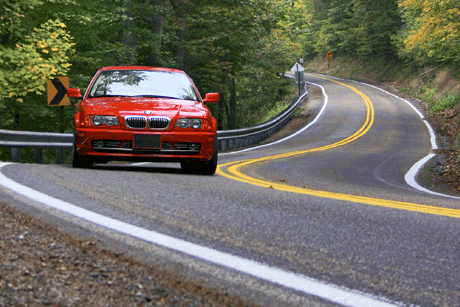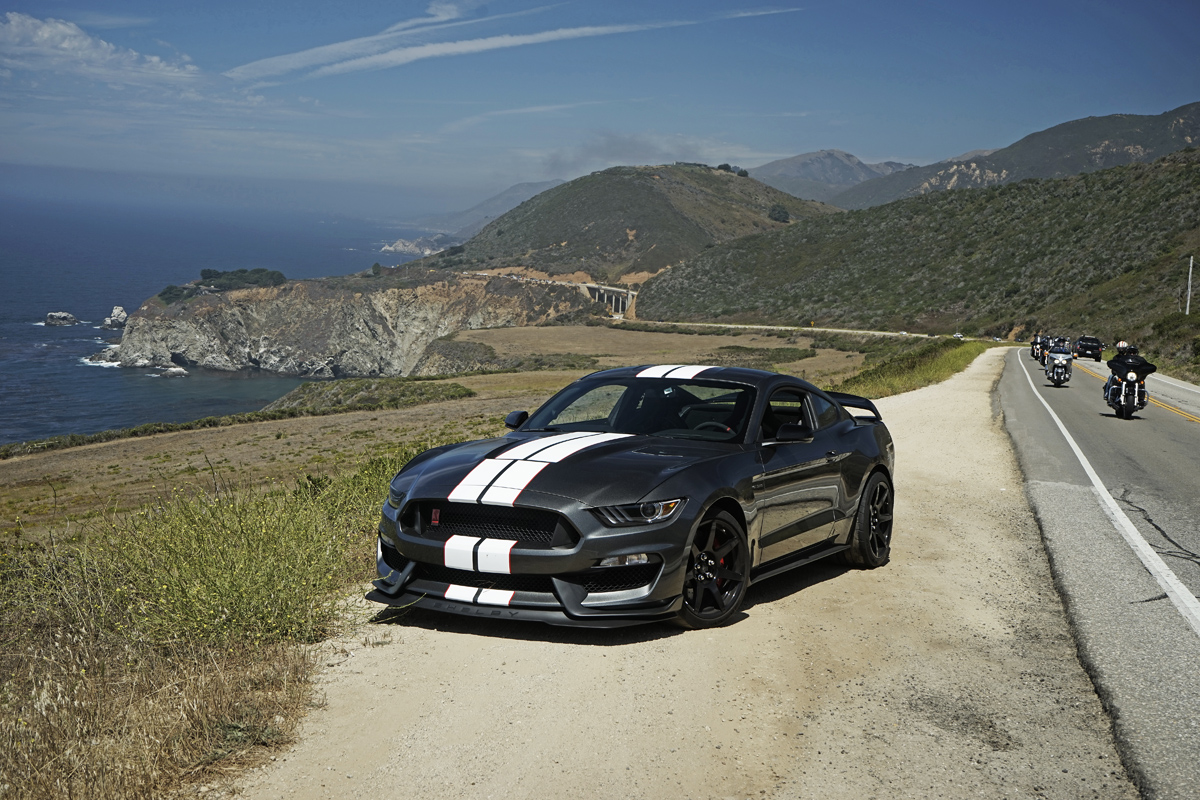
Recently, Praxis Advanced Suspensions invited us for a day-long test drive of its BMW 330ci test car through rural Pennsylvania en route to BeaveRun Motorsports Park Northwest of Pittsburgh for a lapping session on their North Circuit. How well did the acclaimed air suspension system fare?
This one’s for the die-hard Bimmerheads! Especially the 3 series fans, who may actually find themselves driving to the track for a lapping session in the very same car they use for everything from work and school commutes to personal errands and shopping trips. Of course, only you know how multi-purpose your BMW is (or isn’t). But, if you’re an E46 owner (’99-04 BMW 3 series coupe, sedan or wagon) and you’re tired of sacrificing everyday drivability with mixed-and-matched aftermarket parts, the Praxis Advanced Suspensions E46 air suspension system may be just what you need to get out of that rut.
Backed by the deep pockets of Bridgestone/Firestone, both cash and technology-wise, the Praxis kit considers all tunable elements of the system, including springs, dampers, bushings, tires, suspension alignment and suspension geometry to optimize performance over the widest range of conditions possible. The system replaces most of the E46 factory suspension and the average amateur mechanic can tackle the installation in less than 10 hours using hand tools. Pre-assembled parts, including a BMW-specific wiring harness, ECU and mounting brackets simplify the job, which requires no cutting or drilling.
Each corner benefits from high quality Firestone air springs with anodized 6061 T-6 billet aluminum caps and pistons, plus externally adjustable inverted H&R monotube dampers. Compressed air is stored in a trunk-mounted reservoir that’s fed by an onboard air compressor.
Firestone’s proprietary Intelliride electronic control system is used to adjust vehicle height and spring rates while a trunk-mounted ECU monitors an accelerometer and height sensors at each suspension corner. The ECU interprets suspension data and commands the valve-block to direct airflow to individual air struts in order to maintain desired ride height and spring rate.
Once installed, the driver uses a cockpit-mounted controller to dial in any of the three available suspension modes to match the vehicle’s performance to actual driving conditions. The first is ‘touring’ mode and it’s the most similar to the factory vehicle. In this mode, which is mode is ideally suited for commuting on major highways, secondary roads or driving in bad weather such as snow or sleet, the factory ride height is maintained while the spring and damping rates are tailored to deliver a similar ride and handling to the original vehicle.
Pressing the middle controller button will automatically put the car into ‘sport’ suspension mode and, in a few seconds, lowers the car a full 25mm so you can enjoy a more spirited commute, or a jaunt on your favorite road. The system is not entirely self-regulating though. Each time a new mode is selected, the driver can opt to also manually adjust the shocks’ rebound from outside the car–by turning the little knob on the bottom of the shock–to reap the greatest rewards for that particular setting. It’s a relatively simple affair with a set of mechanics gloves; but, the cool thing is that Praxis has already done the hard work, and can tell you exactly how many turns, and in which direction, so that you don’t have to go through the process.
Praxis’ marketing man extraordinaire, Mike Swope, recently let me test drive the Praxis BMW 330ci you see here. Guided by his trusty Magellan navi unit, we spent a full day driving the rural roads between Pittsburgh and Beaver Valley, PA (roughly 35 miles Northwest of Pittsburgh). Let me start by saying I couldn’t have been more impressed.
When going from touring to sport mode, the handling is noticeably more responsive–yes, sporty–with much less body roll and sharper steering response. In the twisty sections, the car is more neutral and the Intelliride completely transparent.
There are a few other key features that make Praxis-equipped cars handle like they’re on rails. The first is side load compensation, which is natural to the system because the air springs are mounted at an angle to the strut, thus allowing the spring to compensate for bending loads inherent in strut suspensions.
Typical coil-over suspensions can be experience up to 250 pounds of bending load, at the expense of ride quality and product life. And, because Praxis can independently control airflow to each suspension corner, corner weighting is automatically adjusted with the vehicle’s ride height. Furthermore, Praxis specifies a custom alignment that considers the effects of suspension geometry changes to provide balanced tire wear in all three modes.
The final setting is, of course, ‘track’ mode, which decreases ride height by 37mm and increases spring rates by 80 percent. It offers the firmest damping setting and is intended for amateur motorsport activities on the track or in the cones. As such, we had to make a special trip to BeaveRun Motorsports Park to see what it can do.
BeaveRun’s North loop is where Praxis has done the lion’s share of its R&D work. Getting the lapping session going, Swift puts the car into touring mode and gives me the lay of the land. After a few laps I take the wheel and try to replicate his line, but it’s pretty hard because the car isn’t exactly doing what I want it to. It’s understeering and body roll is quite prevalent as in the factory ride. I wrestle with the car for a few laps before putting the car into sport mode, which I’d become quite familiar with over the course of the day. Steering is much sharper now and there is substantially less body roll. The more taught suspension is making things easier, but I’m still not hitting all the apexes.
After several laps in sport mode, we switch over to track mode. By the end of turn three, I’m totally amazed at the difference in handling. In track mode, the car is sprung like a racecar and sits much closer to the ground. Hitting the apexes is now a cinch, and bolting down the back stretch you can feel every single imperfection in the track. The sense of speed has increased and I’m feeling very confident now. So much so I thought I could make it through turn four without letting off the gas this time. I nailed the apexes at three and four and, as a result, the car rewarded me by hopping off the track and sending me into a 720 spin into the grass. No damage, but this action was more than enough evidence to convince me this setup is “no nonsense” and “not for the faint of heart,” as Praxis suggests.
On our drive back to Pittsburgh, Swift and I recounted the day. I got what I’d come for–proof that the Praxis system really can turn your daily-driven BMW into a track menace–and Swopes noted the grin on my face had not subsided whatsoever. The kit performed much better than I’d expected it too. And, honestly, I was skeptical it would be able to deliver the goods they said it would. Besides the standard 3 series, Praxis has a kit for the E46 M3. They’ve also got applications for Subaru’s Impreza WRX and even the VW Golf GTI, which Praxis announced at the last SEMA Show.
If you own one of these cars and are into to amateur racing, the Praxis air suspension system is definitely worth your consideration. The E46 kit goes for under $4,000 and is well worth the money. All items are warranted for use in sanctioned, amateur motorsport applications and the air struts themselves come with a two-year unlimited mileage warranty. All other components are covered for one year with unlimited mileage.
1999-2004 BMW 3-Series (E46)
Coupe (323, 325, 328, 330)
Sedan (323, 325, 328, 330)
Convertible (323, 325, 328, 330)**
Wagon (323, 325, 328, 330)**
M3
Praxis Spring Rates (lb/in)
Mode Touring Sport Track
Front 250 325 460
Rear 440 680 770
– 2 Front strut assemblies (air-springs with anodized 6061 T-6 billet aluminum caps/pistons, performance-tuned rubber-isolated strut mounts, externally-adjustable H&R inverted-monotube dampers)
– 2 Rear air-springs with anodized 6061 T-6 billet aluminum caps/pistons
– 2 Rear dampers (externally-adjustable H&R inverted monotube dampers)
– Air handling unit (integrated: compressor, air-dryer, valve-block)
– ECU (Electronic Control Unit with BMW specific software)
– Cockpit mounted User Interface
– Accelerometer
– Air storage reservoir (7.6 liters)
– 4 Electronic height sensors
– 4 Height sensor linkages
– BMW specific mounting brackets (no cutting or welding required)
– BMW specific wiring harness
– Complete installation hardware package
– Comprehensive, illustrated installation manual
